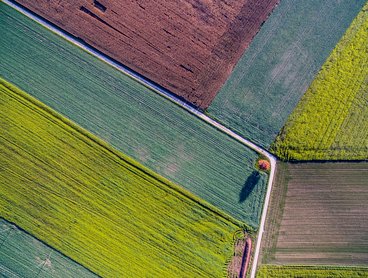Written by Ann Nordby for BBE
Feeding a growing planet is one of humanity's biggest challenges. Ironically, another huge problem is poverty among some of the very people who are growing the world's food. Added to the problems of food security and income inequality is the urgent problem of the climate crisis.

How did this situation come about? During the 20th century, agricultural production exploded due to advances like mechanization, hybridization, fertilizers and pesticides. Transportation allowed staple foods such as corn, wheat and rice to be traded globally. These innovations fed many more people, but also created new challenges for the 21st century.
Today, small farmers with few resources compete with big producers in rich countries. "Small farmers never win by growing staple crops, because of the international commodity market," said Professor Zhenong Jin of BBE.
Drawing on his background in mathematics, earth science and machine learning, Jin has developed ways for farmers to get accurate information about their fields, plan ahead and make good decisions. By using AI and remote sensing, Jin and his team can create precision maps that humans cannot. He provides them to government partners, as as well as development nonprofits that fund agricultural projects.
Jin's process uses Google Earth Engine together with artificial intelligence to answer questions that can't be answered by people. Google Earth Engine is a cloud computing platform for processing publicly available satellite imagery and other geospatial and observation data. It is basically a database of images from NASA and European Space Agency satellites from which people like Jin can extract data. Satellite imaging contains resolution to down to about one meter. But there is too much data for humans to sift through. That's where AI comes in.
AI can process large amounts of data, recognizing patterns and making decisions and judgements the way humans do. Jin's team writes SCRATCH code to extract the information they want. It can accurately count and locate the number and species of trees growing in a given area. It does this because the code tells it to look for tree shape, color and size, leaf texture, factoring in the time of year and rainfall in a given area.

Behind the tools are mathematical models based on what we know about how plants grow. "You have data points," Jin explains. "Greenness, point in time, and other qualities. You have some information that you know. From even one data point, you can extrapolate if you have the right formula."
Countries such as Benin, Togo, Ghana and Morocco are shifting their agricultural production away from commodity crops. Higher-value specialty crops fetch higher prices and don't have to compete with commodity crops. Trees also offer resilience: Drought years may reduce yields, but unlike grains, tree crops are unlikely to fail completely. In addition, trees capture carbon. Carbon sequestration stabilizes the climate, and it offers an additional revenue stream for farmers who participate in carbon trading programs.
One of Jin's partners is the Moroccan government, which is spending billions of dollars to transition its agricultural production from wheat to olives. They asked Jin and his team to come up with a baseline inventory of crops planted across the country. Using Google Earth and AI, the team was able to tell the government precisely how many olive trees were growing, their exact location and spacing. Using this information, the government began to plan where to locate their agricultural supply centers and crop distribution routes. They knew exactly how much to pay farmers in subsidies, and how much output to expect at season's end.
Precision mapping can help farmers to optimize their fertilizer input, know where to irrigate. It can help governments to monitor water quality and know whether their agriculture programs are working. It can also expose yield gaps - places where trees could be producing more. Jin's model accurately predicts crop yield based on factors such as field conditions, days since planting and weather. This knowledge helps farmers to plan ahead, or change tree spacing. When disasters occur and farmers need to make a crop insurance claim, there is no need to send an agent to the field to take random samples or make a crude estimate of loss based on average yields in the area. Crop insurance claims can be paid speedily and accurately by subtracting the actual yield from AI-predicted yield. This speed can make the difference between planting or missing the window for planting in a given year.
Jin's work is tackling the biggest problems of the 21st century. "Solving these problems depends on monitoring and predicting impacts of farming practices on agricultural production and planetary health. It's crucial to base our decisions about management, adaptations and practice on science." In short, we need to know what assets we have, where it is and how they're being used before we can know what to change.
Jin also played a leadership role in the recent UMN-lead $20 million National AI Institute focusing on climate-smart agriculture and forestry.